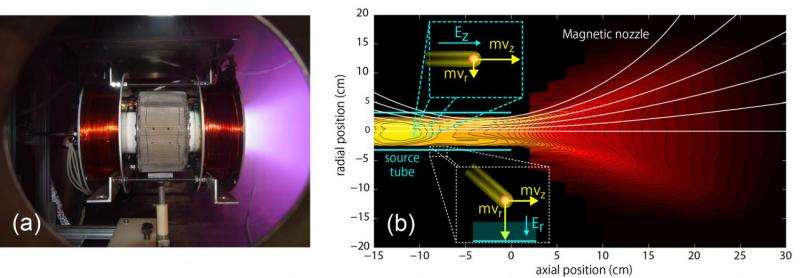Performance degradation mechanism of a helicon plasma thruster

A part of the performance degradation mechanism of the advanced, electrodeless, helicon plasma thruster with a magnetic nozzle, has been revealed by the research group of Dr. Kazunori Takahashi and Prof. Akira Ando at Tohoku University's Department of Electrical Engineering.
An electric propulsion device is a main engine, and a key piece of technology for space development and exploration. Charged particles are produced by electric discharge and accelerated, i.e. momentum is transferred to them via electromagnetic fields. The thrust force is equivalent to the momentum exhausted by the device, and the spacecraft can thus be propelled into space.
Mature electric propulsion devices such as ion engines, hall thrusters and magnetoplasmadynamic thrusters have electrodes exposed to the plasmas. Ion sputtering and erosion damage these exposed electrodes over time. For propulsion systems that are used over a long period, electrodeless propulsion devices have been suggested and rigorously researched as an alternative option. These are represented by the Variable Specific Impulse Magneto-plasma Rocket (VASIMR) and the helicon plasma thruster.
In the helicon plasma thruster concept, the charged particles in a high density helicon plasma source is guided to the open source exit and accelerated by the magnetic nozzle via a magnetic expansion process. Various gain and loss processes of the particle momentum occur in the thruster, significantly affecting the propulsive performance, where the thrust force is equivalent to the momentum exhausted from the system.
It has been considered that the major momentum loss occurs at the source lateral wall, where the "radial" momentum is transferred to the wall via an electrostatic ion acceleration in the plasma sheath. This might be true. Although the loss of the axial momentum there has been treated as negligible, data from experiments clearly show the presence of the "axial" momentum lost to the lateral wall, which is transferred by the radially lost ions.
This significant axial momentum loss seems to have originated from the internal axial electric field in the plasma core, which appears to be more enhanced by the highly ionized plasmas for the future high power operation of the helicon plasma thruster. More detailed understanding of the plasma dynamics will hopefully lead to further development of the advanced high power and electrodeless electric propulsion device.
The detailed observations of the momentum loss will be published by the American Physical Society in their journal Physical Review Letters on May 8.
Journal information: Physical Review Letters
Provided by Tohoku University


















